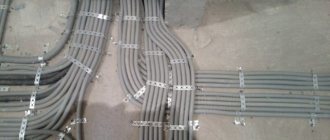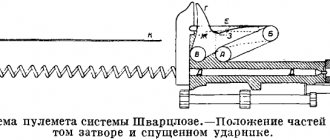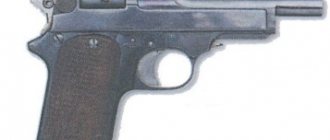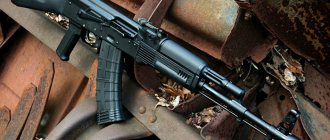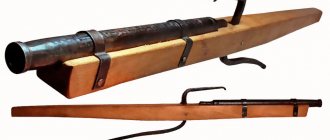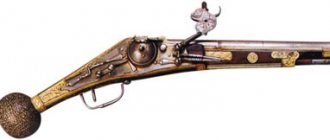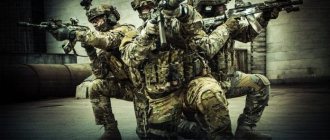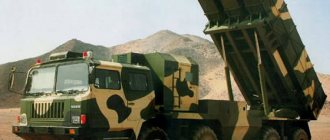Gate
Gate
We have already established that the barrel of a modern gun is a pipe.
The hole in the muzzle always remains open. The hole in the breech should only be open when loading; When firing, it must be tightly closed. This closing is done by a shutter. The barrels of guns loaded from the breech are equipped with bolts. During a shot, they take on the pressure of the powder gases. Therefore, the bolt must tightly close the barrel bore to prevent gases from escaping out. In addition, the bolt must reliably lock the barrel, that is, at the moment of firing, the bolt should not open spontaneously.
Reliably locking the bore when fired, the bolt should simply and easily open after a shot to reload the gun and close easily and tightly after loading. In this case, opening and closing the shutter should be done either with a simple hand movement without expending much effort, or automatically.
In large-caliber guns, the energy of special engines is used to open and close the bolts, since the bolts are very heavy.
The bolt is designed not only to close the barrel. It is equipped with mechanisms for firing a shot and for ejecting the cartridge case after the shot.
The types of shutters are very diverse. The most widely used valves are wedge and piston valves (Fig. 24).
Rice. 24. Types of valves: a - wedge valve with a horizontal wedge seat; b - wedge gate with a vertical wedge seat; c - piston valve
.
The wedge gate has the shape of a tetrahedral prism. The front face of such a prism is perpendicular to the axis of the barrel bore, and the rear supporting edge is inclined relative to the front. This is done in order to make it easier to open and close the bolt and ensure the tightest closure of the barrel. A wedge socket is a through slot in the breech of a gun. The shape of the socket in the breech corresponds to the shape of the wedge. When fired, the wedge rests on the edges of the grooves of the wedge socket. Depending on its direction, the wedge socket is called horizontal or vertical. In the first case, the wedge moves to the side, and in the second case it moves from top to bottom.
The horizontal movement of the wedge is advantageous, since in this case the force for opening and closing is distributed evenly, but it also requires space for the wedge to exit to the side. With a vertically moving wedge, the force on the handle is very uneven and, with a large weight of the wedge, it can be unbearable for a person, therefore, such shutters are equipped with special mechanisms in the form of springs, which are cocked when the shutter is opened and reduce the energy of the fall of the wedge, and when closing, make it easier to lift it.
When closing, the wedge slides into the socket and slides in it along guides parallel to the rear edge; the front edge, moving parallel to itself, approaches the rear edge of the barrel and delivers the cartridge to its place.
When opening, the inclined edges of the protrusions make it easy to extend the wedge and open the channel even when the bottom of the sleeve is strongly pressed against the front edge of the wedge.
When fired, the pressure of the powder gases on the front edge of the wedge is transferred through the rear edge to the wedge part of the breech. The tensile force can be decomposed into two components: one, directed perpendicular to the rear edge, tends to tear off the wedge part of the breech, the other, directed along the inclined edge, down or to the side, tends to throw the wedge out of its socket (see Fig. 24 6
). The greater the angle of inclination of the rear edge, the greater the force tending to throw the wedge out of its socket. In modern tools, this angle is close to zero, therefore, the force acting along the inclined edge is close to zero.
The breech itself prevents the wedged part of the breech from coming off, and the friction force counteracts the ejection of the wedge from the socket.
Thanks to the presence of a wedge socket with grooves, the length of the breech part of the gun is reduced, which is undoubtedly beneficial. However, this design is less durable, since the cheeks of the socket, not connected at the back, can come apart. This type of wedge socket is used mainly in small-caliber guns. The use of a wedge socket with shaped grooves eliminates the possibility of cheek divergence.
In modern artillery, wedge bolts are usually used in guns with separate case and cartridge loading. In these cases, obturation and protection against gas breakthrough is provided by the sleeve itself, which, expanding under the pressure of powder gases, is tightly pressed with the outer surface to the walls of the chamber, as a result of which gas breakthrough to the outside is eliminated. Therefore, the use of a wedge bolt for separate case and cartridge loading does not require the use of any special sealing devices.
In older systems, the wedge breech was used in cap-loading guns. Obturation in these tools was ensured by a special device - an obturator. But the obturating devices used did not give good results. Therefore, the wedge bolt is not used for case loading in modern artillery guns.
Compared to other types of bolts, the wedge bolt has a simpler design and reliably locks the barrel bore. Closing and opening the wedge requires one straight-line movement, which ensures the simplicity and speed of operation of such a valve, especially since elevation angles do not affect the amount of force required for opening and closing, especially in valves with a horizontal wedge. This circumstance facilitates the automation of wedge valves. In modern artillery, semi-automatic bolts are in most cases wedge-type.
Vertical wedge gates are usually used in small-caliber guns, where the weight of the wedge is small and the change in forces on the handles when opening and closing is negligible, as well as in guns where opening and closing is automatic. The use of vertical wedge gates is advantageous in cases in which the sideways extension of the wedge limits the angle of horizontal fire due to the emphasis on the carriage frame or other parts of the gun.
In addition to manually operated wedge valves, there are also semi-automatic and automatic ones. Full or partial automation is carried out by using the force of powder gases during recoil.
Semi-automatic bolts use this force to open, eject the spent cartridge, and close. Loading and firing a shot is done manually. Most modern small and medium caliber artillery pieces have a semi-automatic breech. These weapons include the 45-mm anti-tank gun mod. 1937 and arr. 1942, 76-mm gun mod. 1939 and model 1942, etc. There are bolts in which only closing is automated (76-mm mountain gun model 1938).
During firing, without any effort from the gun crew as a result of the action of powder gases, the automatic shutter opens, loads the gun, closes, fires a shot and ejects the spent cartridge case. Small caliber anti-aircraft guns, as a rule, have automatic shutters.
In addition to wedge bolts, some artillery guns also have piston bolts.
Piston valves are used in medium and large caliber guns. The main part of the locking mechanism of a piston valve is a cylinder with a screw thread on the outer surface, called a piston. When the bolt is closed, the piston is screwed into the rifled bolt seat of the barrel, ensuring reliable locking of the barrel when fired. The high pressure of the powder gases on the piston necessitates a larger number of turns. The design of such a piston, in the form of an ordinary screw, would require a lot of time to open and close the shutter. To speed up the operation of the bolt, the threads on the piston and in the bolt seat are not made along the entire circumference, but alternate with smooth sections. The most commonly used pistons have two grooved and two smooth sections. In such a piston, each section corresponds to a sector with an angle of 90 degrees. There are pistons with three and four pairs of threaded and smooth sections.
When closing, the piston is installed with threaded sectors against the smooth sectors of the bolt seat and in this position is pushed into the seat over its entire length. After the piston is pushed in, it rotates at a certain angle (90, 60, 45 degrees), while the piston coils engage with the bolt seat coils. Thus, instead of a large number of revolutions of the piston around the axis, closing is done by turning it through a small angle.
Cutting off part of the turns speeds up the operation of the bolt, but at the same time reduces the strength of the piston in the barrel. To increase the strength of engagement, the number of turns on the piston is increased, which causes an increase in the length of the piston, and therefore an increase in its weight. Both of these factors reduce the gun's rate of fire.
To reduce the length and weight of the piston and increase the strength of its connection with the breech, so-called stepped pistons are sometimes used. Such pistons have sectors of different heights, that is, the cutting is done with different diameters, according to which the bolt seat is cut.
Some valves use conical stepped pistons. The diameter of such a piston increases towards the breech. This makes it possible to reduce the length of the piston, since due to an increase in the diameter of the coils, the strength of the piston increases. However, conical pistons are rarely used due to the complexity of their manufacture. Frictional forces arising at the point of contact between the surfaces of the piston turns and the bolt seat prevent the piston from turning under the action of powder gases. In addition, the shutter in the closed position is locked with special devices, which also eliminates the possibility of opening the shutter when firing.
Obturation in piston bolts of guns with separate cartridge and cartridge loading, as in wedge bolts, is ensured by the sleeve. The situation is somewhat different with case loading. When the bolt is closed, a small gap is formed at the point of contact with the body of the gun, through which highly heated gases can break through. Gases passing through the gap at high speed can melt the metal and, thus, render the valve unusable. In addition, these gases, escaping back, can cause severe damage to the gun crew. And finally, the destructive effect of gases can damage other parts of the shutter that are not designed for high forces. Gas breakthrough cannot be eliminated by careful processing and precise adjustment of the contacting surfaces, because gases constantly strive to tear the bolt out of the gun and penetrate into any free space. Since gas breakthrough is completely unacceptable, the valve itself must have a special device that prevents the flow of gases. This device is called a seal.
The seal must be made of plastic material so that under pressure it can take the shape of surrounding surfaces. The shutter is placed in the breech so as to cover the gap between the bolt and the body of the gun when fired.
In modern shutters, only automatically operating seals are used, that is, those in which tight locking is carried out exclusively under the influence of the pressure of the powder gases. Automatic seals can be divided into two groups: the first - seals whose action is based on compression, the second - seals whose action is based on stretching. The first group includes a mushroom-shaped seal, the second group includes metal sleeves and trays.
The mushroom-shaped seal (Fig. 25) consists mainly of an annular cushion and a mushroom-shaped rod.
Rice. 25. Shutter with mushroom seal
.
The ring pillow is made of canvas, stuffed with asbestos, soaked in lamb fat and pressed under high pressure. It is placed on the front end of the piston and is held in place by a mushroom-shaped rod that has a through ignition channel. The mushroom-shaped rod has the ability to move somewhat along the axis.
At the moment of firing, under the influence of powder gases, the mushroom-shaped rod moves backward and flattens the cushion, which is pressed against the walls of the chamber, eliminating the possibility of gas breakthrough. To ensure that the cushion material is not pressed into the gaps between the bolt and the barrel, the seal has steel split rings, which, under the pressure of the cushion, when fired, are unclenched and pressed against the corresponding surfaces. Due to the elasticity of the cushion and rings, after the shot they return to their original dimensions and do not make it difficult to open the bolt.
To close the bolt, the piston is installed with threaded sectors against the smooth sectors of the bolt seat and is pushed in to its entire length, after which the piston is rotated at a certain angle so that its turns engage with the turns of the bolt seat. Consequently, the translational and rotational movements of the piston when opening and closing are performed by a simple action on the handle. For ease of opening and closing, the piston is mounted in a frame pivotally connected to the barrel breech using an axle. At the end of the axis there is a handle. To close the bolt, you need to turn the handle all the way to the breech. This will cause the shutter to close completely.
Based on the number of simple piston movements performed when opening and closing the valve, two- and three-stroke piston valves differ.
In push-pull piston valves, when closing, the piston moves along with the frame in an arc until it is completely inserted into the bolt seat, and then rotates around the axis, screwing into the seat. When opening the shutter, the movement is performed in the reverse order.
In three-stroke piston bolts, when closing the bolt together with the frame, the piston is brought to the breech section, moving along a circular arc, then moves out of the frame and slides into the piston seat, moving along the axis of the barrel bore, and rotates until the threaded sections are completely engaged, in other words, the piston is screwed into bolt socket. When opening the shutter, the movement occurs in the reverse order.
According to the location of the frame axis, piston valves, like wedge valves, can be horizontal or vertical. In the first case, the frame axis is located vertically, and the rotation of the frame together with the piston occurs in a horizontal plane. In the second case, the frame axis is located horizontally, and the piston rotates together with the frame in a vertical plane.
We have already said that the bolt is designed not only to lock the barrel, so the design of a modern bolt, in addition to the locking device, includes several other mechanisms.
The main mechanism of any shutter is the locking mechanism.
In wedge valves, the locking mechanism consists mainly of a wedge that moves using cranks and a handle mounted on one axis (Fig. 26 a
). The crank rollers fit into grooves on the wedge. When the handle moves forward, the crank rollers press on the edges of the grooves, forcing the wedge to lower, as a result of which the barrel bore opens. To close the bolt, the handle must be turned back.
Rice. 26. a - locking mechanics of the wedge gate; b - locking mechanism of the piston valve; c - impact mechanism of the wedge gate; d - firing device of the piston bolt.
In a push-pull piston valve, the locking mechanism consists of a piston (Fig. 26 b
), frame, comb and handle mounted on an axis. When you turn the handle back, the spike of the handle will pull the comb, which with its teeth is engaged with the toothed sector of the piston. The piston will rotate around its axis until its threaded sectors disengage from the threaded sections of the piston seat. At the moment of complete disengagement, the protrusion on the handle axis will rest against the edge of the arc groove on the frame. Further movement of the handle will be associated with the movement of the frame itself, which, together with the piston, will rotate around the axis of the frame and remove the piston from the socket. The shutter is closed by moving the handle in the opposite direction.
Vertical valves use a balancing mechanism to eliminate the influence of the weight of the wedge or piston when opening and closing the valve. When the shutter is opened, the lever mounted on the handle axis compresses the spring of the mechanism. The force of the compressed spring balances the weight of the shutter, so closing it is easy and effortless. In wedge valves, the force of the compressed spring exceeds the weight of the valve; in this case the shutter closes automatically.
To prevent spontaneous opening of the shutter, there is a special closing device that is included in the locking mechanism. In a wedge valve, such a device is an arc section of the groove and a recess for the crank roller. The wedge cannot move until the handle with the cranks rotates through a certain angle and the roller comes out onto a straight section of the groove.
In a piston valve, locking is done using the tooth of the handle. To open the bolt, you need to push the handle down, this will disengage the tooth from the frame and the handle can be turned.
In Fig. Figure 24 shows an open wedge gate and a horizontal wedge seat.
To fire a shot, there is a firing device in the bolt. In wedge gates, the most common firing devices are those consisting of a striker and a trigger mechanism.
The impact mechanism consists of a striker, cocking, mainspring and cover (Fig. 26c
). The mainspring is placed between the firing pin partition and the cover secured in the firing mechanism socket. To fire a shot, the firing pin must be pulled back and thereby compress the mainspring; then release it. Under the action of the expanding mainspring, the firing pin will sharply move forward and strike the cartridge case primer with its striker.
The firing device of the piston bolt is placed inside the frame pipe, around which the piston rotates (Fig. 26 a
). The main parts of the device are a firing pin with a firing pin, cocking and support sleeve or nut, a mainspring, a firing pin tube and a trigger with a roller.
How does the shooting device work? Pull the long trigger arm towards you. The trigger will begin to rotate around its axis and its hook will pull the firing pin back. At the same time, the short arm of the trigger with its roller will begin to press on the tail of the firing pin tube, sending it forward. The mainspring, enclosed between the firing pin support sleeve and the annular shoulder of the tube, is compressed. But then the firing pin platoon breaks away from the trigger hook and the firing pin with the clutch begins to move forward under the action of the compressed mainspring; Having encountered a piston ledge on its way, the clutch stops. The firing pin moves further by inertia, the firing pin extends beyond the front cut of the piston and breaks the cartridge case primer. If the piston is not fully engaged with the bolt socket coils, that is, the bolt is not completely closed, it is impossible to fire a shot. In this case, the hammer tube with its tail rests against the arc protrusion of the piston.
Pulling the trigger to fire a shot is done using a trigger cord or a trigger rod mechanism.
Occasionally there are such cases: you release the striker, but there is no shot. After some time, a shot is heard completely unexpectedly. What happened? There was, as the artillerymen say, a prolonged shot. Premature opening of the bolt during prolonged shots is very dangerous and can lead to injury to the gun crew or disable the gun. To avoid this, modern guns use inertia-type fuses in case of prolonged shots.
The main part of such a fuse is a massive body, which is placed either in the bolt or in the breech and can move in its socket along the axis of the barrel. When the bolt is closed, the fuse moves so that it connects any part of the bolt with the breech. Consequently, it is no longer possible to open the shutter with a normal movement. During recoil or rewind, due to inertia, the safety releases that part of the bolt that it connected to the breech during closing, and then the bolt can be opened with a simple movement. But if the shot does not occur, then you can open the shutter only after turning off the safety.
To eject the spent cartridge case after a shot, both types of bolts have special ejection devices, the action of which is based on the principle of a first-class lever. Typically, the ejector consists of one or two branches mounted on one common axis. The axis serves as a support during the action of the ejector.
In addition to the mechanisms described above, the breech of modern guns has folding trays, which serve to guide heavy projectiles during loading. To prevent the head of the projectile or the leading band from touching the protrusions and irregularities in the bolt socket during loading, there are guide strips. The guide bar must ensure free sliding of the projectile during loading; in order to remove the guide bar when closing the shutter, no additional movements are needed: the bar is raised and lowered using a lever mounted on an axis connected to the shutter handle. When you turn the lever, the bar rises and moves slightly forward. When the lever is turned back, it lowers and does not interfere with closing the shutter.
A retainer is sometimes placed in the upper part of the bolt socket, the purpose of which is to prevent the cartridge case or cartridge from falling out when loading at large elevation angles. When the bolt is opened, under the influence of its own weight, the long end of the holder lowers and remains in an inclined position, freely allowing the projectile and cartridge case to pass through during loading, but not allowing them to fall out. When the bolt is closed, the piston raises the retainer.
What are small arms
A small weapon is a weapon whose main components are a barrel, a locking mechanism and an igniter that initiates the combustion of gunpowder. That is, the general principle of operation is this - the cartridge is fed into the barrel, locked by a special mechanism, the igniter ignites the powder mixture of the ammunition, under the impact of the hammer or firing pin, depending on the type of firing mechanism (trigger). Next, the bullet, moving along the barrel under the influence of powder gases, accelerates and hits the target with a certain force at a certain distance, taking into account the features of pistol devices.
The firing range and power of the cartridge are directly related to the amount of gunpowder.
